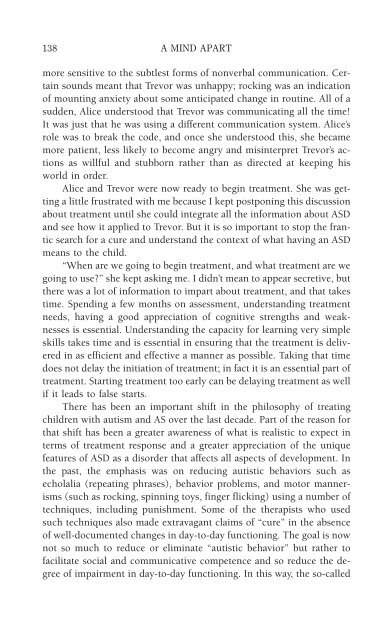978-1572305441
autism
autism
You also want an ePaper? Increase the reach of your titles
YUMPU automatically turns print PDFs into web optimized ePapers that Google loves.
138 A MIND APART<br />
more sensitive to the subtlest forms of nonverbal communication. Certain<br />
sounds meant that Trevor was unhappy; rocking was an indication<br />
of mounting anxiety about some anticipated change in routine. All of a<br />
sudden, Alice understood that Trevor was communicating all the time!<br />
It was just that he was using a different communication system. Alice’s<br />
role was to break the code, and once she understood this, she became<br />
more patient, less likely to become angry and misinterpret Trevor’s actions<br />
as willful and stubborn rather than as directed at keeping his<br />
world in order.<br />
Alice and Trevor were now ready to begin treatment. She was getting<br />
a little frustrated with me because I kept postponing this discussion<br />
about treatment until she could integrate all the information about ASD<br />
and see how it applied to Trevor. But it is so important to stop the frantic<br />
search for a cure and understand the context of what having an ASD<br />
means to the child.<br />
“When are we going to begin treatment, and what treatment are we<br />
going to use?” she kept asking me. I didn’t mean to appear secretive, but<br />
there was a lot of information to impart about treatment, and that takes<br />
time. Spending a few months on assessment, understanding treatment<br />
needs, having a good appreciation of cognitive strengths and weaknesses<br />
is essential. Understanding the capacity for learning very simple<br />
skills takes time and is essential in ensuring that the treatment is delivered<br />
in as efficient and effective a manner as possible. Taking that time<br />
does not delay the initiation of treatment; in fact it is an essential part of<br />
treatment. Starting treatment too early can be delaying treatment as well<br />
if it leads to false starts.<br />
There has been an important shift in the philosophy of treating<br />
children with autism and AS over the last decade. Part of the reason for<br />
that shift has been a greater awareness of what is realistic to expect in<br />
terms of treatment response and a greater appreciation of the unique<br />
features of ASD as a disorder that affects all aspects of development. In<br />
the past, the emphasis was on reducing autistic behaviors such as<br />
echolalia (repeating phrases), behavior problems, and motor mannerisms<br />
(such as rocking, spinning toys, finger flicking) using a number of<br />
techniques, including punishment. Some of the therapists who used<br />
such techniques also made extravagant claims of “cure” in the absence<br />
of well-documented changes in day-to-day functioning. The goal is now<br />
not so much to reduce or eliminate “autistic behavior” but rather to<br />
facilitate social and communicative competence and so reduce the degree<br />
of impairment in day-to-day functioning. In this way, the so-called



